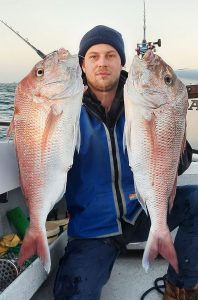
Sammy Whitworth with a pair of respectable Corio Bay Reds.
Corio Bay/Bellarine Peninsula
Snapper are about, and – as usual – it’s the early birds getting the proverbial worms.
Paul Rahman and Goran Nedic were at anchor off Clifton Springs by 4.00 am on Wednesday, and – using the heads of King George whiting for bait – they’d each taken their respective bag limits of snapper by daybreak, all were around the 3 kg mark.
Also making an early start in 8.5 metres of water off Point Richards, just south of the channel, were Andrew Phillips and Mark Sesar. The bite was hot and they each took their respective bag limit catches of fish, both under and above 40 cm.
Snapper have also been caught within the Corio Bay inner harbour, and while not in the numbers encountered in the outer. They have been larger with Jason Treloar and Harley Griffiths picking up the occasional fish to 7 kg off North Shore.
And, among those to have sent me photos, and videos, of their snapper catches from Corio Bay last week was Sammy Whitworth. While not passing on much information, he’d obviously caught some great fish.
Rod Ludlow of Beachlea Boat Hire at Indented Head reports that whiting and squid are the main species sought, both by clients and independent anglers.
Among them on Friday afternoon were Jeff Richards and Chris Hateley whose first order of business was catching squid, which they did in spades before heading out to Dead Man’s Stick on the Prince George Bank in time to catch the flood tide.
They picked up several good size whiting to 40 cm and better before the bite slowed down and they decided to move, and with the breeze picking up, that was closer into shore where they raised their tally to 24 before it just became too rough to continue.
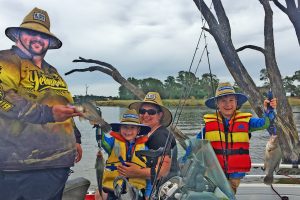
Shane and Jean McCallum with their sons Jack and Logan with yellowbelly on Cairn Curran Reservoir (Picture: Amber Wild).
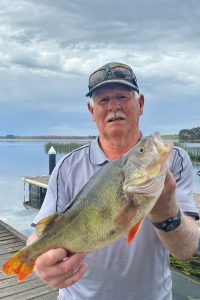
Terry Lindsay with his 48 cm redfin (Picture: John Clements).
Freshwater
Kevin Wild of the Maryborough Angling Club reports that Cairn Curran Reservoir is still fishing well, producing yellowbelly and redfin, and that wife Amber also caught, and released, a 61 cm Murray Cod here last week.
Kevin also reports the Loddon River continues to produce good size yellowbelly with club member Craig Raulston picking up several good specimens at Bridgewater using worms for bait.
John Clements of the Lake Purrumbete Holiday Park reports that redfin have been present in good numbers and there are some good ones among them as Terry Lindsay could attest having caught a beauty of 48 cm. John caught another of 45 cm, while Colin Gathercole of Werribee scooped the pool on redfin to 35 cm on soft plastics.
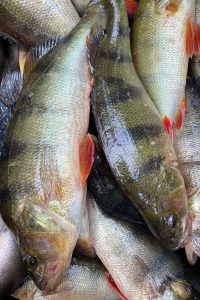
A good sample of redfin from Lake Purrumbete (Picture: John Clements).
Off the beach
With extra low evening tides last week, Tony Ingram and Col Simmons fished RAAFs Beach at Ocean Grove where a good deal of the beach was exposed, giving access to the deeper water beyond.
Initially there wasn’t much doing, but they caught a couple of pinkie snapper on sun-down. Following that, they had some problems with, what were possibly sea lice, taking their baits, but they persisted, and – just as the incoming tide began covering the beach – they caught a couple of slightly larger snapper, one nudging 50 cm.
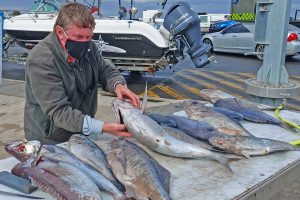
Lachie Wombell busy at the Portland cleaning tables with his, and Bob McPherson’s catch of gemfish and blue-eye trevalla (Picture Bob McPherson).
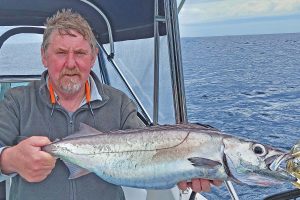
Lachie Wombell with a gemfish taken offshore from Portland (Picture Bob McPherson).
Cohen asks:
Geoff, I have read both your references to trevalla and trevally over the years. Are they the same species, or are they different?
Cohen, using Sea Fishes of Southern Australia (Hutchins and Swainston) as a reference, the trevallies – and there are many varieties – are grouped as Carangidae, our most common being the silver trevally. However, greater diversity is to be found in tropical and semi-tropical waters.
Trevalla, on the other hand include only three species, grouped as Centrolophidae. The most common is the warehou, referred to locally as the snotty trevalla. The spotted trevalla – which is similar in size and shape to the warehou, but as its name suggests it is spotted – is less infrequently encountered inshore, usually schooling at some depth.
The third in the group, and the largest, is the blue eye trevalla, which may reach lengths of 1.4 metres and possibly 50 kg, but are usually much smaller. This is a deep water species, most abundant along the edges of continental shelves and is a valued catch by anglers bottom-fishing off Portland and other areas with access to deep water.
